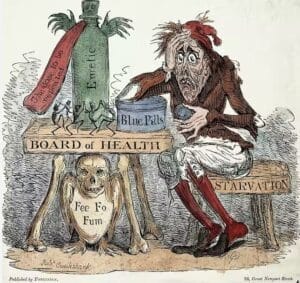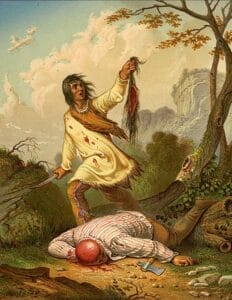
Vital Statistics / Health, Wellness, and Hygiene
*The 1810 Census shows 7.2 million people were living in the United States of which 1.1 million were slaves.
*The average woman had over seven live births in 1800. All too often, a young wife would die when complications occurred during childbirth.
*In 1800, the mean life span was about 25. Diseases such as smallpox, malaria, tuberculosis, pneumonia, influenza, rickets, and fevers caused many deaths in both children and adults.
*Mortality rate for infants was between 43% and 50%. Before passing on a family name, some people did not name their infant children until they knew the child would survive.
*Families circa 1800 tended to have a larger number of children than today’s families. Midwives, who delivered babies, were extremely important since all babies were born at home.
*It was a common practice at this time not to change a wet or soiled infant before the diaper dried.
*Most people studying this era relay that death by burning (followed childbirth) were the leading cause of death among women …while there are some that believe that to be inaccurate… Burning fires likely caused respiratory issues as well.
*Wells for drinking water could be contaminated by nearby privies and unpenned animals, causing many illnesses. Early homes had no bathroom, septic system, or running water. Chamber pots and privies performed the function of today’s toilets. People in this period were accustomed to living with smells that we would consider repugnant…. and if one lived in a city or town, there was filth ……..There was no plumbing or sewage control at this time.
*Most people bathe or shower daily today, a practice that adults and children of the colonial period would have considered odd. They did not believe in bathing every day, or even every week. They felt that bathing washed away the layer of dirt that was their protection against germs and disease. Most baths consisted of washing with a cloth dipped into a basin of water. When washing in warm water was desired, water had to be heated in the fireplace.
*No chemical deodorants or anti-antiperspirants masked body odors; however, since nearly everyone shared the same standard of cleanliness, odors were not as offensive.
*Winter meant less bathing –just washing or less cleaning of clothing which leads to germy environments.
*Most family illnesses were treated at home. Settlers used medicinal herbs and other simple remedies. In addition, bloodletting endured as a common medical practice well into the 19th century. Throughout the ages, bloodletting has been prescribed as a treatment for everything from a sore throat to the plague.
Scalping
One potential atrocity that settlers in Northwest Ohio faced was Indian attacks –especially during the war of 1812. This brutal activity was practiced by both Native Americans and Frontiersmen.
Scalping wasn’t just a way to claim a trophy from the body of a dead man. Some people were still alive and struggling when a warrior would pull back their head and slice off the skin at the top of their skulls. While most victims of scalping passed away, there were instances where a person was scalped and either was not otherwise wounded or the wound was not mortal.
The problem then becomes how to medically treat a patient with a scalped head. Frontier medicine was often harsh at best. A scalping victim could survive without treatment—but not for long. They would live for a few months with exposed bone at the top of their heads until infection set in. Their skulls would get inflamed, and the bone would become necrotic and start to separate, slowing exposing their bare, unprotected brains.
The first treatments for those scalped where when doctors pierce the skull to the bone marrow. Opening up little holes into the bone marrow, the doctors wrote, would make a “flesh projection” grow over the wound. This was achieved by taking an awl and boring numerous holes throughout the damaged area. For the victim, this caused more excruciating pain.
Apparently, the success rate for this treatment, called “pegging”, was very good. The scalped head would “cure very slowly” and the average recovery period was two years. Occasionally, some hair would even grow back on the new scalp. The patient would regain feeling once the new skin grew sufficiently to attach to the edge of the uninjured part of the original flesh remaining on the skull. Some scalping survivors thought that the pain from pegging was equal to or worse than the pain of being scalped.
Isolation
When Ohio first opened for settlement, it was oft said that a squirrel could travel from Cincinnati to Michigan without touching the ground. Much of Northwest Ohio was dense forest. That having been said, isolation created serious problems. Father Boeke, a St. Marys, OH native, published his grandmother’s diary titled “Liwwit Boeke -An American Pioneer.” The diary discusses women going mad from long term darkness and isolation….as the nearest cabins were often miles apart. Women were often alone while men went on military campaigns, hunts, or if their spouse needed to travel for supplies.
So you wish you lived when? Comparing then to now, healthcare alone tips the scales for me…
Welcome to “Sharing the Stories of History with Tim Mann”!
Meet Timothy A. Mann, a passionate historian born and raised in the heart of Shelby County, Ohio where Tim’s roots run deep in the rich soil of American history. As the author of articles and books, including “Frontier Miscellany Concerning the Miami County Ohio Militia,” “Colonel John Mann, His Kith and Kin,” and “Frontier Militia – The War of 1812,” Tim’s literary contributions have enlightened and inspired countless history enthusiasts.
Join Tim Mann on a journey through time as he shares fascinating tales, untold stories, and hidden gems from the annals of history. Let’s delve into the past together and uncover the wonders that await in “Sharing the Stories of History with Tim Mann.”




